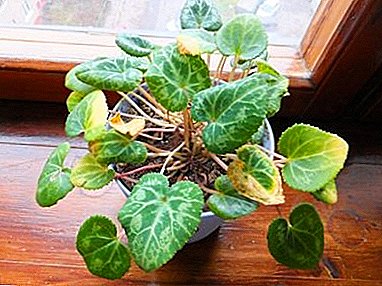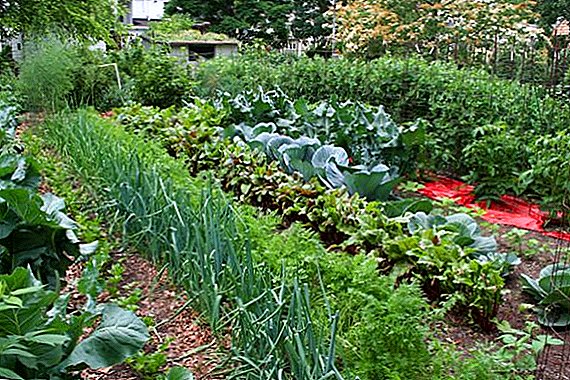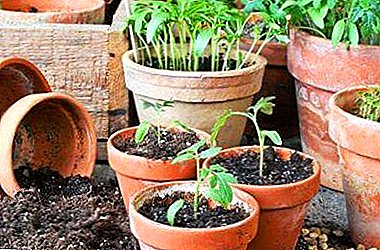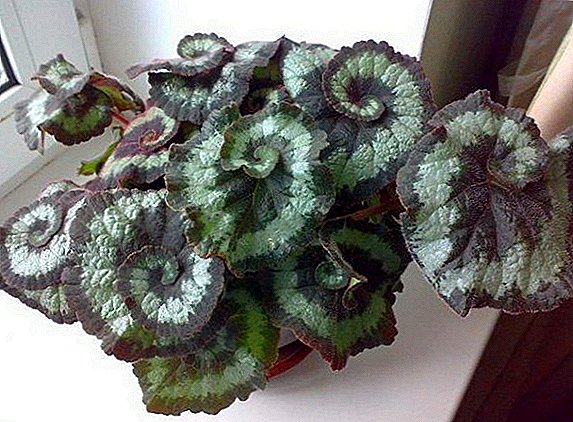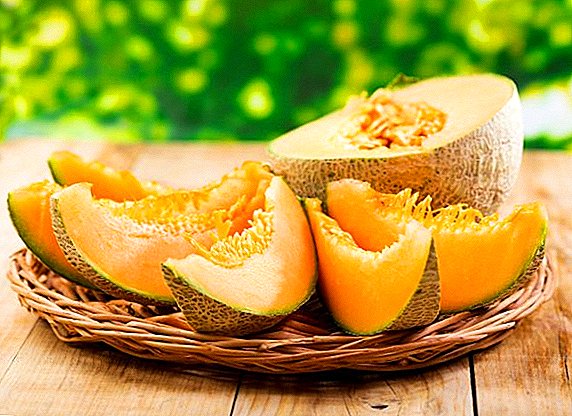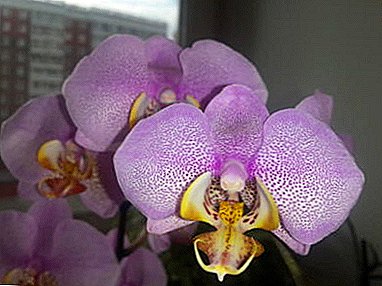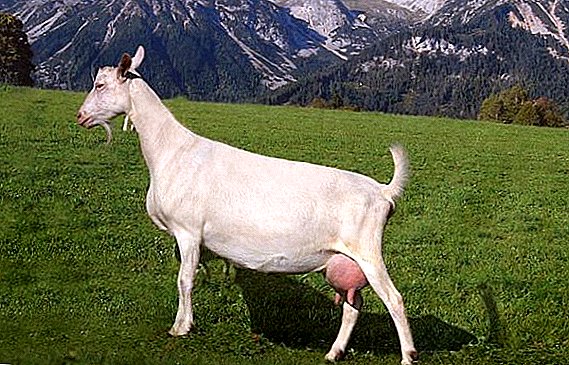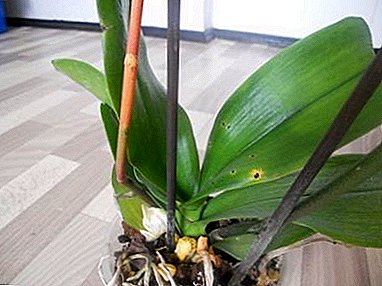
Yellow peduncle is not always a natural aging process, sometimes this is caused by inappropriate conditions of detention. Therefore, you should not be surprised if you buy a green and blooming orchid in the store, and after a while it was completely covered with yellow. If you normalize the parameters of the content, the plant will be restored, and the peduncle will look different.
What does the yellowed flowering shoot mean and what does it look like?
Orchid peduncle is considered to be an arrow on which buds appear.. As a result of the lack of chlorophyll, the pigment that is responsible for the green color, lightening of the color occurs. Yellowing is manifested as a result of adverse factors that directly affect the processes of vital activity. The spike usually begins to turn yellow at the tip. It becomes pale yellow. Gradually, the whole arrow acquires the same shade.
The process of yellowing, drying means a lack of fluid, loss of elasticity, stiffness of the peduncle. As a rule, the appearance changes gradually. The flower sprout is visually reduced in size, the shape is deformed, reddish hues can be seen on it.
Reference! For some varieties of orchids, the red and purple tint of the peduncle is considered normal and is not a disease.
Simultaneously with the arrow yellowness are cast, the stem. Such a phenomenon may indicate ailments. The dry part of the plant ceases to participate in photosynthesis, there are no intercellular metabolic processes in it, full or partial dying of living tissue occurs.
In dendrobium, the stem is performed by a bulb.
What is the danger?
 Surely if the flower has turned yellow after flowering, there is nothing to worry about and no need to worry about what to do. This is a natural process. It is worse when, in addition to the color-bearing process, other orchid organs turn yellow.
Surely if the flower has turned yellow after flowering, there is nothing to worry about and no need to worry about what to do. This is a natural process. It is worse when, in addition to the color-bearing process, other orchid organs turn yellow.
Mass yellowness of green shoots indicates the presence of disease. It is necessary to respond to the symptoms in time and help exotics. Otherwise, a protracted disease can lead to complete drying of the root system, impaired overall development, stunting, lack of flowering, worsening of the condition due to infectious diseases, and the death of the plant.
Why is this happening?
Orchids can turn yellow and dry due to non-observance of the basic rules of care and violation of the maintenance parameters.
Air humidity
Humidity should be at least 30%, but not more than 80%. If this indicator is broken, the flower stalk fades, becomes soft. Accordingly, the buds are also showered. In some cases, there are processes of decay. This parameter is important to keep on control, if necessary, use a household humidifier.
Incorrect location
Choosing a place for an exotic beauty is of immediate importance. With the arrival of the season of cold and rain, the sunlight of the orchid is lacking. Optimal conditions are to maintain a 14-hour daylight hours. But at home, it is not always possible to perform. Therefore, without additional lighting, the flowers begin to wither, turn yellow, fall off.
In the summer, the bright sun can hurt. Ultraviolet in large quantities leaves dark spots on the leaves and inflorescences., thermal burns.
Oversupply or undernutrition
 Mineral fertilizers should be applied with caution, especially which contain a lot of nitrogen. This component promotes growth and a set of green mass. Frequent use of fertilizing leads to drying out of foliage, peduncle, flowers, and roots.
Mineral fertilizers should be applied with caution, especially which contain a lot of nitrogen. This component promotes growth and a set of green mass. Frequent use of fertilizing leads to drying out of foliage, peduncle, flowers, and roots.
Lack of nutrition also negatively affects the condition of the plant. They are weaker, they lack immunity, the leaves and flowers are small, underdeveloped, pale color. You need to make sure that everything is in moderation if symptoms of fasting appear, feed the flower, but do not feed it. Preparations should be used strictly according to the instructions.
Stress
Relocation for orchids does not pass without a trace. After all, this becomes a different lighting, humidity, temperature. And the capricious plant will react that hour. For a while it can stop blooming, reset buds. However, in the future, provided that the exotics like the new conditions, everything will be fine. Just orchids need a period of adaptation.
Damage
Accidental mechanical damage caused by inattention of the wearer may cause yellowing and dying of the floral arrow. It may be broken or bent, therefore, moisture and nutrients do not flow into the damaged area.
Diseases
As a result of an improperly organized irrigation system, Orchids are often diseases associated with rot, such as: fusarium, late blight. In this case, yellowing and drying of the peduncle is a minor symptom of the appearance of infection. In addition, there are brown-red spots on the leaves, dark areas of the root system. Such illnesses cause serious damage to the plant. The treatment is carried out with systemic fungicides.
When is this a natural process?
 If the plant has released a flower stalk, it has safely faded, and after 3-5 months the flower-bearing sprout has dried up - this is a natural process that does not require any interventions.
If the plant has released a flower stalk, it has safely faded, and after 3-5 months the flower-bearing sprout has dried up - this is a natural process that does not require any interventions.
There are two options for developments after flowering:
- The flower arrow stays green, so the orchid is preparing for the next bloom.
- The peduncle turns yellow, so the plant dries it on its own. Water and useful trace elements cease to flow to it. Perhaps the flower is not strong enough to maintain this part. The orchid retires to release a new, green arrow with the onset of spring.
Reference! Some flower growers deliberately cut off the faded part, without waiting for the yellowing, so that the next bloom is more magnificent.
What to do - step by step instructions
Resort to radical methods pruned spike recommended in 3 cases:
- a diseased or weakened plant;
- there was a long and abundant flowering, after which a period of rest does not occur;
- spike dried up.
If the tip that spoils the appearance of the flower has begun to dry up, it can be cut off.
Tools should be prepared for the liquidation process in advance.. This may be a knife or pruner. Be sure to sanitize tools.
- Carefully inspect the orchid.
- Check for infectious diseases or pests, stem, leaves, aerial roots.
- To inspect the underground roots, you should remove the flower and feel the root sprouts.
- If there are symptoms of rot or fungal diseases, apply fungicides and remove the flower in a separate room.
- Using a sharp knife, cut 1 cm above the live kidney. If not, then leave a stump no more than 2 cm.
- Treat open wounds with crushed activated charcoal.
- Other dry parts of the flower can be removed in the same way.
- Orchid do not water a week, give time to adapt.
The first time after the procedure is better not to touch exot at all. Moisturize minimally, exclude fertilizers, limit sun exposure, lower the temperature in the room where the plant is located. In the spring, all complex activities resume.
Prevention
In order not to worry about the health of an exotic beauty, when it blooms, and the peduncle will begin to turn yellow, dry, care must be taken.
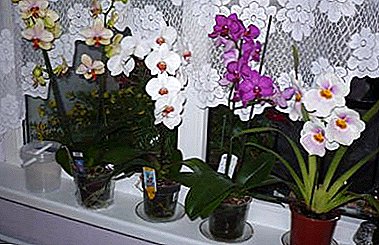 Lighting create scattered, scorching rays of the sun to shade.
Lighting create scattered, scorching rays of the sun to shade.- Maintain a comfortable temperature not higher than + 25 ºС, and humidity within 60%.
- Spray every day, several times a day.
- Do not forget to ventilate the room.
- Once in 3 years to update the soil.
- Moisturize moderately, do not allow the bay. Water to take clean, without impurities.
- Perform timely feeding and protection from pests.
If there is a sharp yellowing of the leaves, the peduncle act immediately. Determine the cause that provoked the drying out and take remedial measures. Then the orchid will be a healthy and valuable indoor plant, with beautiful, exotic flowers.


 Lighting create scattered, scorching rays of the sun to shade.
Lighting create scattered, scorching rays of the sun to shade.